How to choose an electric heated floor: guidelines for choosing the optimal heating system
Comfort and coziness in the home largely depend on the optimal temperature regime.A convenient and effective way to ensure favorable conditions is to use underfloor heating. There are two options for such complexes: water circuit and electrical systems.
The latter are considered universal, as they are suitable for apartments, private houses and premises for various purposes. Such heating systems are easy to install and convenient to use.
Before choosing an electric heated floor, you should study the characteristics and features of various modifications and compare their parameters with the upcoming operating conditions. All these points are described in detail in the article.
In addition, we have provided practical recommendations for purchasing a reliable system, as well as installing a heated floor yourself.
The content of the article:
General criteria for choosing the optimal system
The electric underfloor heating system can be used in any room, both as primary and additional heating. Here it is important to choose the right model from the entire variety offered by manufacturers.
Before choosing a specific model, you should decide whether it will be the main or additional heating. Also, you should immediately decide for which specific rooms you will need to purchase a heated floor system.

It must be borne in mind that for each room a separate system with a separate thermostat is purchased. After all, the operating conditions of the bathtub, kitchen and loggia are completely different. As well as temperature requirements. Therefore, the systems will be different.
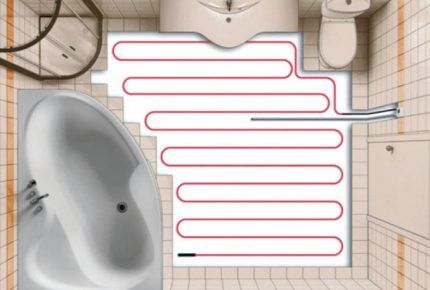
The choice of optimal equipment for installing heated floors will be influenced by the following parameters:
- room area;
- the general condition of the premises - whether repairs are underway or not;
- proposed decorative flooring;
- required system power;
- is there an alternative source of heating;
- how much you plan to spend.
By answering all these questions, you can choose the most suitable option that will satisfy all your room heating needs.
So, if the room area is small, there is basic heating and full-scale repair work is not planned, then it is quite possible to choose a decent option for the electrical system. Moreover, it will be easy to install and will not spoil the original appearance of the room at all.

When purchasing a heated floor set, do not forget about the main selection criteria - the appearance of the product and the accompanying documentation. Every conscientious manufacturer gives a guarantee for its equipment and always includes instructions that contain recommendations for operation and installation.
If there is no guarantee and the seller finds it difficult to show the quality certificate, then you should not buy the product from him. There is a high probability of coming across a fake, the low price of which will result in a full-scale repair in 2-3 years.
As for the appearance, having chosen the desired system, you should not hesitate to check that the equipment specified by the manufacturer in the documents corresponds to what is actually offered.
You should also pay attention that during a detailed inspection there are no visible damages - scratches on the film or broken rods, damaged insulation on wires and other problems.
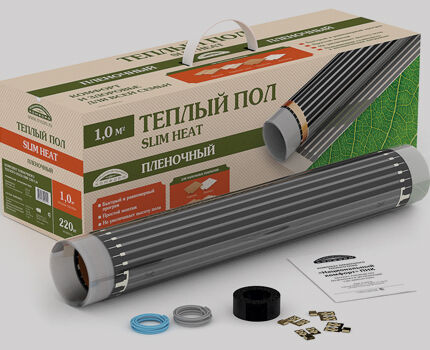
You should immediately select additional materials specified in the manufacturer’s instructions. You can often find recommendations to use branded thermal insulation, protective film, and more.
Do not neglect such advice - as a rule, components from one manufacturer are ideal and then the heated floor system will serve its owner for the maximum possible time.
The choice of an electric underfloor heating system is justified by the following advantages:
Options for electrical underfloor heating systems
Heated floors that use electricity as a power source are used more often than their water counterparts. This option is especially relevant in city apartments as additional heating of individual rooms.
A comparative assessment of water and electric heated floors is given in this article.
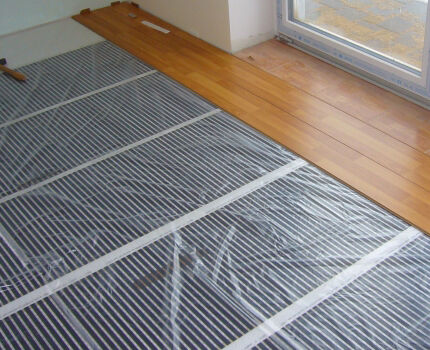
Electric underfloor heating, depending on the type of system, is:
- cable;
- shielded;
- film;
- core.
Cable systems. The main role is played by the heating cable. It can be unshielded or shielded. The first is used in technical rooms to insulate individual structures, for example, to avoid freezing of pipes, and for other purposes.
Shielded cable is used in residential premises, in the bathroom, in the kitchen, in the loggia, etc. This heating option is produced by various manufacturers. Moreover, the power, length and operating voltage of products may be different. The manufacturer indicates these parameters directly on the cable.
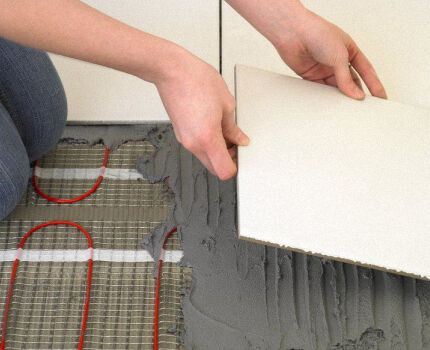
Film systems they work thanks to a heating element represented by carbon or its mixture with other components. Different film manufacturers differ in the type of application, power, expected load and ability to self-regulate. All of them belong to infrared systems.
Rod warm floors are characterized by high cost and long service life. They can be used in any room and beyond.
Based on the heating principle, electrical systems are divided into:
- convection;
- infrared.
The first includes all cable models, and the second includes films and carbon rods. Infrared systems have the highest heat transfer - about 97-98%.The heat emitted by infrared floors warms all objects within their visibility range. Moreover, this radiation does not harm the human body at all.
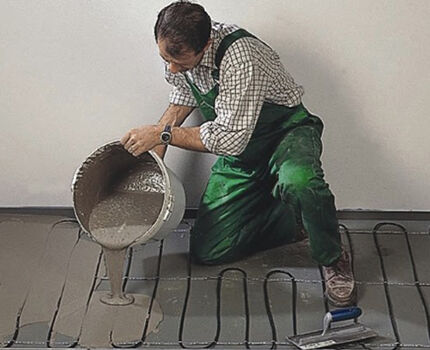
Electric heated floor: selection rules
Heating systems that use electricity can be economical or not. It all depends on the correct choice of the heated floor kit. If all factors of the premises are taken into account, then maintenance costs will be insignificant. The main thing is to install the system according to the recommendations.
Film: when to choose it
The film belongs to infrared systems. It can be solid or segmented. Supplied in rolls of various lengths, widths and capacities. The load for which it is designed can also vary significantly.
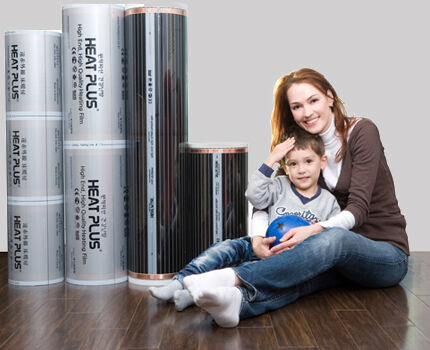
Continuous film is a newer invention. It can be used in areas with heavy loads - gyms, shops, etc. and of course at home.
There are special models designed for use in rooms with special temperature conditions and humidity levels, for example, in infrared saunas. These are models from South Korean manufacturers.
Segmented heating film, depending on the appearance of the carbon heating element, is most often found:
- striped;
- wavy;
- in the form of a honeycomb;
- with perforation.
Manufacturers specially developed the latter option for laying in a screed. Its special shape ensures good adhesion to the base of the floor.The power of such models is greater than that of their striped counterparts.

The striped film is laid on a soft base - a heat-insulating material. Solid can also be laid on a rigid base. When purchasing, be sure to take into account the recommendations specified in the instructions - what kind of base should be provided before installing the film.
Many companies focus the buyer's attention on the fact that it is not advisable to install their equipment under tiles. Therefore, such films should absolutely not be used in the bathroom.
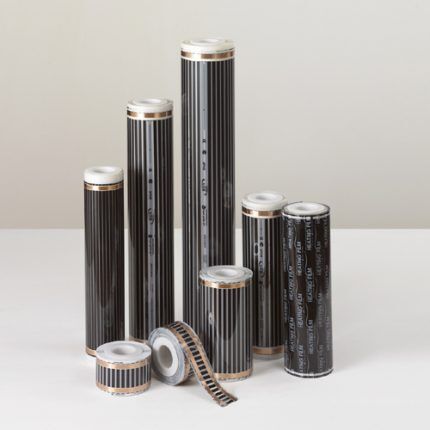
In most cases, carbon films can be laid in the kitchen, on the balcony, as main and additional heating. It is permissible to install the film not only on horizontal, but also on vertical surfaces - on the wall as additional protection from the cold. These are the so-called heating systems PLEN.
Another criterion is the possibility of self-regulation. Not all inexpensive films can do this. This parameter is inherent in continuous films. They are more economical and warm up faster. The manufacturer gives a guarantee of 20 years or more for solid ones. They are able to withstand significant loads.
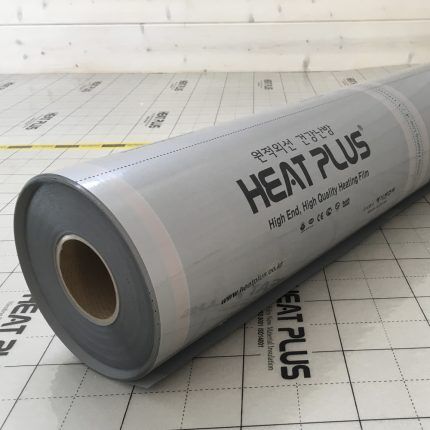
To choose the right film heating system, you need to take into account the area of the room and the presence of massive furniture. Depending on the price category, you should choose the appropriate roll length.
If funds allow, then it is more convenient to focus on solid sets that are prone to self-regulation. In this case, any rearrangement of furniture is not dangerous - the system will not overheat.
Do not forget about the need to buy a temperature sensor and thermostat. Also, they must be installed correctly so that the system operates efficiently and consumes the minimum permissible amount of electricity.
Features of using a rod floor
Electric rod heated floors are an expensive undertaking. These are mats in which heating rods are located parallel to each other. They are connected on both sides by a wire.
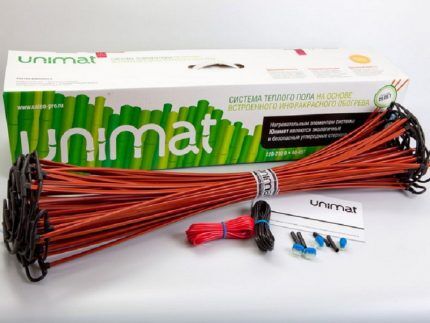
It is important that when laying the finishing coating the master does not damage this wire. Otherwise, the heated floor will be damaged and you will have to call a repair specialist. With proper installation on rod systems, manufacturers provide a guarantee of up to 50 years of service.
Rods used as heating elements come in 2 types:
- carbon;
- galvanized.
Carbon rods flexible and can bend in any direction. The main thing is that they do not intersect during installation. If suddenly one of them burns out, the system will continue to work quietly. Such mats can be chosen for tiles, marble, laminate. They fit into the screed.
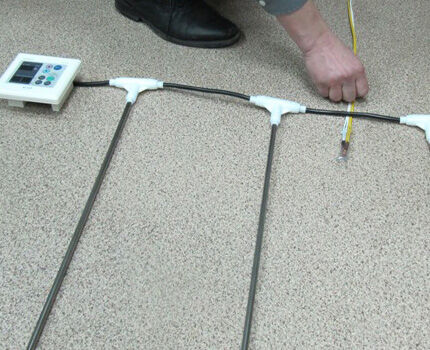
A rod carbon floor can handle heating the room alone if it is additionally insulated from the outside. Also, such a system can be laid in the bathroom and living room.
Galvanized – the heating element is double insulated. The Koreans give a 50-year guarantee on these rods. Even the Chinese have not yet learned how to counterfeit this heating substance.
A mat of galvanized rods is laid only in the screed. It can be used indoors under any type of coating. Also, it can be installed in steps to prevent freezing of sidewalks, to heat soil in greenhouses and for other household needs.
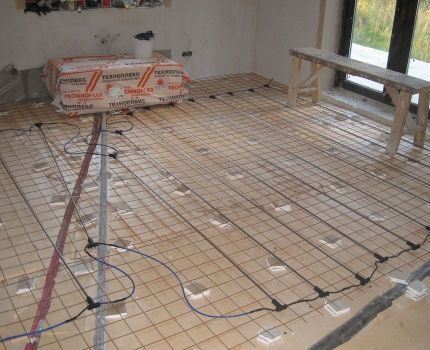
Prerequisites for purchasing a heating cable
Another type of electric heated floors is cable. It comes in the form of a wire of a certain length or in the form of a mat, when a cable is laid on top of a plastic mesh with a certain pitch and fixed.
The heating cable requires skill when laying, especially if it is a coil, the wire from which must be laid out in a certain order. The undoubted advantage is an inexpensive type of heating. The cost of material for creating a system on your own is quite affordable.
When installing heated floors, sometimes they also use self-regulating heating cable.
Cable thickness – 5-7 mm. For the cable, you can lay any power per 1 m2 by packing density. It is placed under the screed, and insulation should be placed underneath - extruded polystyrene foam or foamed polyethylene with non-woven lining, on the reverse side of which a moisture-proof coating is applied.
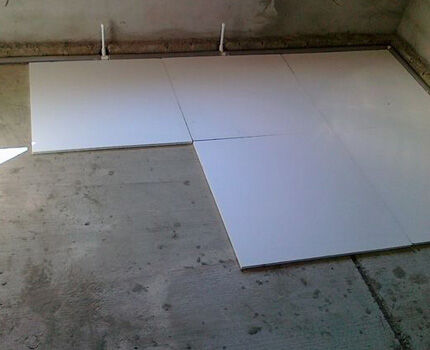
There is a new product on the market with a thickness of 2-2.5 mm - this is the same cable as is used in heating mats. With it, the thickness of the screed will be less. The top can be covered with tiles, linoleum, laminate.
The main disadvantage of the heating cable is that it takes a long time to warm up, it will take up to 3 hours, and the floor height will be from 5 cm.
The mat is the same cable, but with a smaller diameter. It is fixed to the mesh. On the plus side, it is already sold with a certain pitch and power per square meter.
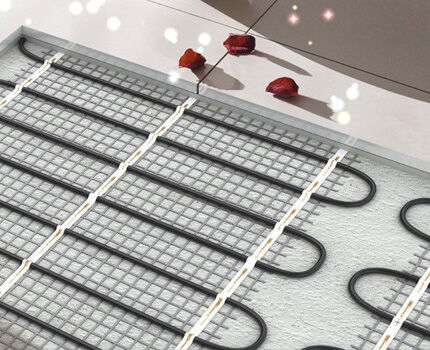
The mat is laid under tiles or other type of covering. The layer of tile adhesive is from 1 cm. The floor warms up quickly and cools down quickly. Manufacturers produce this type of system for a certain area of the room. It is correct to round down, because... You cannot cut the cable.
The heating mat must not be laid on insulation. The mat can be used 10-12 days after laying the tiles. You can pour a self-leveling floor from above. If the cable is mounted in a screed, then you can turn on the floor after 21-28 days, as soon as everything is completely dry.
The service life is on average 15-20 years, provided that it is installed correctly. Accidental damage to the mat is common when tiles are laid on top. Then the whole system fails.
A cable underfloor heating system can be installed both within the city and outside the city. The main thing is that there is a constant power supply.
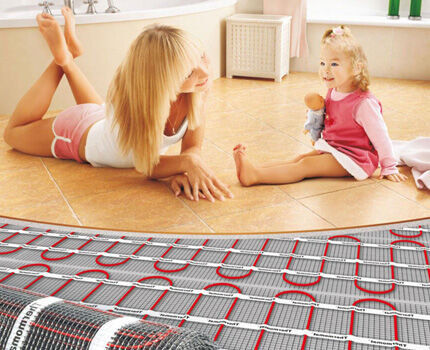
Install it yourself or call a professional?
The question of the upcoming installation of a heated floor system arises even before its purchase.
There are 3 solutions:
- order an installation service when purchasing a system;
- find cheaper specialists on the side;
- do everything yourself.
All these methods have both advantages and disadvantages. The first one is the most convenient and fastest. It is good for everyone, because professionals will do their job efficiently and quickly, regardless of the chosen floor heating system.
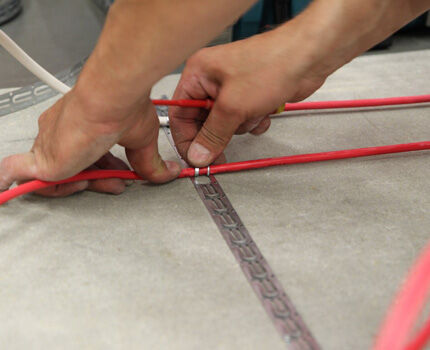
The negative aspect of this service is its cost. The buyer is not always willing to spend a large amount of money on installation. Therefore, out of a desire to save money, he often finds cheaper craftsmen. This decision can sometimes result in even greater expenses.
The fact is that if installed incorrectly, the customer will receive a warm floor, which will stop heating after a short time. And you will have to spend a lot of money on repairs. It is important to contact conscientious, experienced and responsible contractors who have positive recommendations.
The third option is the most reliable. When everything is done with your own hands, the owner is familiar with every centimeter of the installed system. If mistakes were made during the installation process, they are corrected immediately, because everything is done for yourself and your family. And you won’t have to pay outsiders to install the floor.
The process of laying electric floors includes a number of standard steps performed in a certain sequence:
But this option also has a significant drawback - you need certain knowledge about installing heated floors and a couple of days of free time.
Another important point is the installation of decorative coverings. Regardless of what it will be and who will do the installation, you should treat the electric heating system installed in the floor with the utmost care. Especially if a laminate or tile is planned on top as a decorative covering.
In this case, the tiler involved should be warned to be careful.

If at the stage of finishing work the power wires or some other elements of the heated floor were accidentally damaged, then the customer must know about it. You cannot fasten the wires yourself and insulate such twisting. Be sure to immediately call a repair specialist.
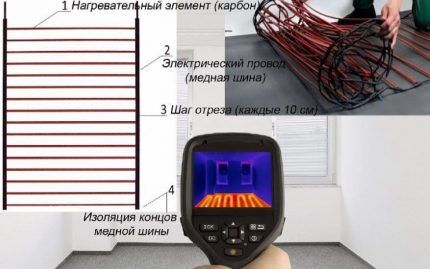
And the customer will not have to search for the right tile model or completely change the top decorative coating if repair work needs to be carried out over a large area of the room.
The specifics of installing electric heated floors under different floor coverings are described in the articles:
- Electric heated floor under linoleum: system advantages and installation instructions
- How to make an electric heated floor under tiles: film and cable options
- Warm floors under laminate: installation and installation of an infrared film system
Conclusions and useful video on the topic
About the pros and cons of the cable and mat for installing a heated floor system:
Video about errors in installing heated floors and repair methods:
About the types of cables and the features of their use for arranging a heated floor system in the video clip:
Connecting and checking the operation of an energy-saving electric rod floor is discussed step by step in the following video:
Having understood the features of using various electric underfloor heating systems and comparing your requirements, you can easily choose the best option. As for its installation and connection, all the work can be done independently.
If you have doubts about your own abilities, then upon purchase you can immediately pay for the installation of the system by professionals.
Do you have anything to add, or do you have questions about choosing an electric heated floor? You can leave comments on the publication, participate in discussions and share your own experience of using underfloor heating systems. The contact form is located in the lower block.




I have a private rubble house, electric heating (electric heaters). Heaters cannot quickly heat a house. We decided to install heated floors. But what type of underfloor heating should you choose? The main room is 12 square meters, there is no electric boiler, you can use a lot of electricity - we have a special tariff plus powerful wires and a meter. Wooden floor (beams). Is it worth filling the floor in the first place?
I have lived half my life in an ordinary private sector, where the electricity is constantly cut off. Therefore, talk about installing electric heating in our house quickly faded away. But still there is not enough water on the gas boiler, because the floors still remain cold. We ignored this as a problem for a long time until we had children and small pets.
We finally decided to install electric heated floors in the bathroom, and just laminate flooring with a warm underlay in the bedrooms. This decision was not reached immediately. First, we studied different options, weighed the pros and cons. As a result, the choice fell on Teplolux cable floors. Reviews on them were quite controversial, but in terms of price/quality ratio they completely tripled us. Already during installation it became clear why for some the heat did not reach the room. It's simple: you need to place them directly under the tiles, already on the finished screed. It is better to pre-fill the subfloor, of course. Well, it wouldn’t hurt to buy a generator. It will come in handy both in winter and summer.
If you have reasonable electricity tariffs, then it makes sense to install electric heated floors in your house. The floor will have to be poured; relevant materials on this issue can be found on our website.
The only thing I can draw your attention to is the expansion joints, or rather their correct installation. They are relevant for large rooms, area from 15 square meters. Attached is a diagram of the correct installation of expansion joints.
Warm floors are a fairly long-term project, both in terms of finances and time, especially if you plan to make the entire house with heated floors. Don’t skimp on the screed, as well as waterproofing, so as not to cause yourself unnecessary problems in the future.